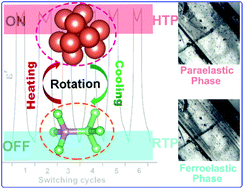A high-temperature halide perovskite molecular ferroelastic with evident dielectric switching†
Abstract
Ferroelastic materials have attracted wide attention due to their great application prospects in energy and information conversion, data storage applications, etc. In this report, we designed and synthesized an organic–inorganic hybrid halide perovskite ferroelastic (TMTB)CdCl3 (TMTB: N,N,N-trimethyl-tert-butylammonium) under the quasi-spherical strategy. (TMTB)CdCl3 shows a structural phase transition at around 356 K (Tc). In the ferroelastic phase, a quasi-spherical TMTB cation is orientationally ordered with the symmetry of mmm. Above the Tc in the paraelastic phase, the crystal symmetry of 6/mmm compels the TMTB cation with multiple orientations showing spherical distribution. The phase transition with an Aizu notation of 6/mmmFmmm agrees well with one of the 94 ferroelastic species. Under a polarized light microscope, the evolution of ferroelastic domains was visually observed. The calculated spontaneous strain value of (TMTB)CdCl3 is 0.0507 based on the lattice parameters. Moreover, (TMTB)CdCl3 shows prominent ‘ON’/‘OFF’ dielectric switches with good reproducibility. Theoretical calculations based on density functional theory (DFT) were further performed to explore the ‘spherical’ – ‘quasi-spherical’ variation of the TMTB cation. This work demonstrates that the quasi-spherical molecular strategy provides a shortcut for discovering new molecular ferroelastic materials, and also provides guidance for the directional design of functional materials.



 Please wait while we load your content...
Please wait while we load your content...